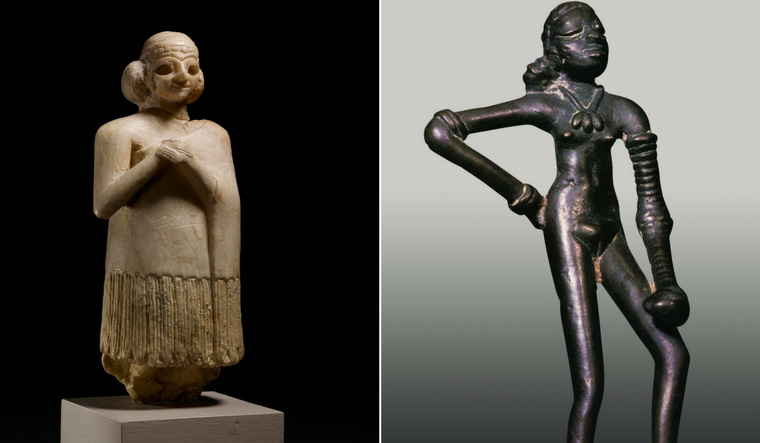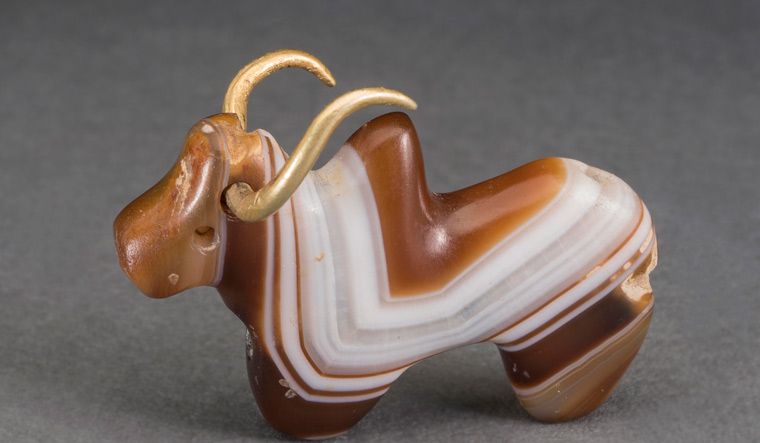This summer the British Museum, at least in a miniscule form, will have moved to Delhi for a brief holiday. On display will be India and the World: A History in Nine Stories—an exhibition, grand in design and size, the kind that Delhi hasn't witnessed for a while before.
Adapted for an Indian context from the popular BBC radio show A History of the World in a 100 Objects, the exhibition has taken a long four years to move from idea to exhibition. Epic— both in terms of scale and size—it brings under one roof 200 objects. There is the British Museum's contributions of course, but beyond that, close to 20 museums and private collectors from India have come together to pool in their works.
The exhibition comes at a time when there is a certain obsession about India's place in the world. History may offer a view but is deeply contested and a minefield. This exhibition, then, is tangible proof—without the loaded aspects of the colour of historians. “To quote Hartwig Fischer, director, British Museum, there has never been a more important time to view India on the world stage,'' says Sabyasachi Mukherjee, director general of the Chhatrapati Shivaji Maharaj Vastu Sangrahalaya (CSMVS) who has been at the heart of this project.
This is also probably the first time that there has been such a mass migration of objects from the British Museum to India. The most travelled piece—the Townley Discobolus—which is a sculpture in marble of a disc thrower, displayed right at the entrance of the CSMVS won't be travelling to Delhi. There have been weight issues apparently, he's just too heavy.
The curators have been on a treasure hunt across India to find objects for this exhibition. The Department of Archaeology in Telangana has provided a turban-shaped panel on Buddha renouncing his kingship—in limestone—that is exquisite. Dating back to 150 AD, the panel is a detailed depiction of Siddhartha leaving the palace and his decision to give up the throne—symbolised by him throwing the crown up in the air. “The divine people in heaven are welcoming his decision, while on earth the common people are crying,” says Mukherjee.
There is a lot to choose from. Soul Houses—from Egypt part of the British Museum collection—tiny pyramids for the common (read poor people). Built out of clay, a little over a foot in size, this is the aam aadmi's preparation for eternity. There is the dancing girl from Mohenjodaro—an iconic statue that is much smaller in real life. And, the beautiful agate bull with golden horns that was found in Haryana and dates back to the Harappan period of about 1,800 BC. This was part of a necklace.
 (L to R): Statue of a woman from the British Museum; dancing girl figurine dating back to about 2,500 BC, Mohenjodaro (from National Museum, New Delhi)
(L to R): Statue of a woman from the British Museum; dancing girl figurine dating back to about 2,500 BC, Mohenjodaro (from National Museum, New Delhi)
The exhibition started out in Mumbai where the objects arrived by air in three or four consignments. A whopping 2,00,000 people in Mumbai came to see the exhibition—the largest crowd that the museum has seen apart from mummy exhibition from Egypt which of course is always fascinating and macabre. It is hoped that Delhiites will come out to brave the summer heat to learn a little bit of history.
“How do you look at Indian history in a global context?'' asked Mukherjee. “This was a question that was in my mind. How do you showcase Indian art and culture in the backdrop of what is happening around the world. Even when we teach, we learn about the Indus valley civilisation, where cities were being built. But what was happening in Mesopotamia and Egypt where pyramids were being built?''
This exhibition aims to give visitors a chance to understand the confluence of culture, how India was influencing the world and how the world was influencing India. “It is a conversation of objects, cultures, religions and human minds.”
The exhibition is divided into nine sections—each representing a different strand of history—Shared Beginnings (1,700,000 years ago to 2,000 BC), First Cities (3,000–1,000 BC), Empire (600 BC – AD 200), State and Faith (AD 100–750), Picturing the Divine (AD 200–1,500), Indian Ocean Traders (AD 200-1,650), Court Cultures (AD 1,500–1,800), Quest for Freedom (1,800–Present), and Time Unbound.
The exhibition has been curated by Jeremy David Hill and Beatriz Cifuentes Feliciano, from the British Museum, along with Naman P. Ahuja, professor at Jawaharlal Nehru University, Delhi. The exhibition will be on view till June 30 at the National Museum.


